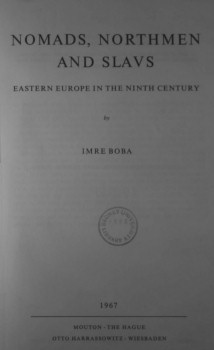 |
Slavo-orientalia.
Band II
Nomads, Northmen and Slavs. Eastern Europe in the ninth century
Imre Boba
Mouton, The Hague Otto Harrassowitz, Wiesbaden 1967 Scans in .pdf format (30.1 Mb) |
 |
Slavo-orientalia.
Band II
Nomads, Northmen and Slavs. Eastern Europe in the ninth century
Imre Boba
Mouton, The Hague Otto Harrassowitz, Wiesbaden 1967 Scans in .pdf format (30.1 Mb) |
Table of contents — Editor’s Preface; Acknowledgements
1. The role of the Dnieper river in the early history of Eastern Europe
“Put’ iz Variag v Greki” — Theories based on the Annales Bertiniani — The testimony of Muslim sources — Byzantine sources and the Russian Primary Chronicle — The role of the Nomads
Nomadic state formations in Europe (sixth to ninth century) — The Avars and the Slavs — Origins of Kiev
3. The Khazars and the eastern Slavs
The chronology of the tributary affiliation of the Slavs — The testimony of Muslim sources — The forms and extent of the affiliation
The fortress of Sarkel on the Don — The Proto-Hungarians in the Pontic steppes
5. The Onogurs in the ninth century
The evidence of Byzantine and western sources — The evidence of Muslim sources
6. The Majghari in Eastern Europe
Theories of the origin of the Magyars (i.e., Hungarians) — A new approach to the controversy; a theory of a Meshcher - Majghari continuity — Meshchers and the Rus center of 'Artha'
7. The invitation of the Ruses
The terms ‘Varangian’ and ‘Rus’ — The historicity of the ‘Invitation’ — The chronology of the ‘Invitation’
The geopolitical situation — Askold and Dir in Kiev — The Ruses: Varangians and Autochthons — The Ruses of Oleg and the Slavs
9. Nomads, Northmen and the Slavs
Index of Geographic, Ethnic and Personal names; Sources and Authorities